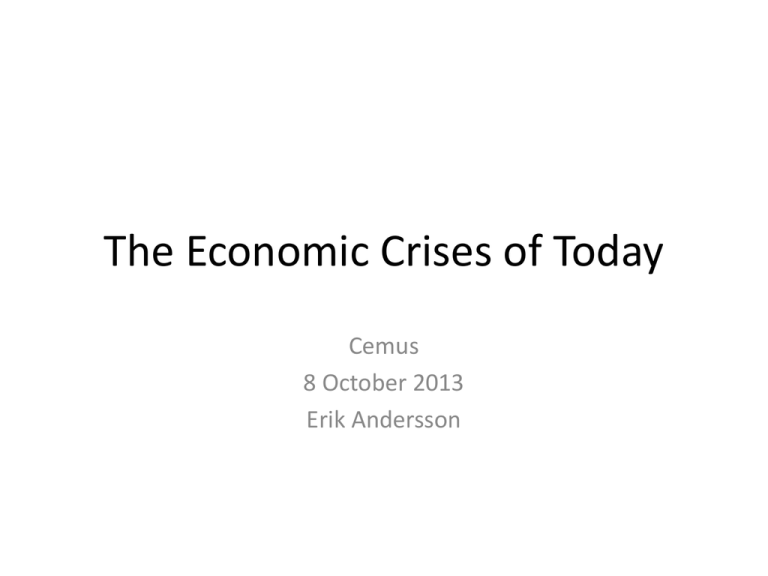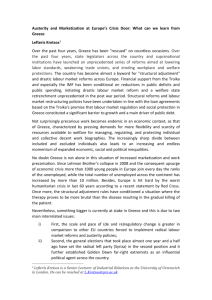The Economic Crisis of Today
advertisement

The Economic Crises of Today Cemus 8 October 2013 Erik Andersson The crisis 10 min on questions pending after ”Inside Job” 2007 mortgage-/real estate crisis in USA Spreads to Europe (Baltics, GIIPS, etc) CDOs and CDSs tip market (actors) over the edge 2008 Lehman defaults => financial chock-wave No-one lends on global financial market Liquidity support from central banks Effects • Layoffs/unemployment when investment and consumption dwindled • Real estate crash • Stock market slump • Soaring official budget deficits • Flight to safety (gold, US bonds, etc) Who was hit? “Subprime” home-owners Laid off workers Savers Who was not hit? “Prime” home-owners Shareholders 2009: Global crisis management G8 turns to G20 and meets in London: Result: IMF gets 750 billion USD OECD swear allegience to IMF FSF 1998 -> FSB 2009 to oversee regulation on financial market: “Basel II and III” Free trade support Credit/loans to the South Business as usual was what was diplimatically possible… No green recovery. National crisis management Bank support TARP in US, Bank gurantees in Irland, etc Industry support Germany and US “cash for clunkers” Subsidised (service) workers in Sweden Low interest rate policies Quantitative Easing in US and Japan no inflation if money ends up on asset markets 2009 – 2012 Big corporate profits back, on smaller sales / Budget crisis in Greece, Ireland, Spain, UK, Italy, Baltic countries etc. USA: • monstrous budget deficit, • big support packages for the national economy, • weak job figures and stock market regains World trade up 25% since 2009, back to pre-crisis levels, but stalling World merchandise trade volume, 2005Q1-2013Q4 Seasonally adjusted index, 2005Q1=100 Source: WTO Secretariat. http://www.wto.org/english/news_e/pres12_e/pr676_e.htm The EURO-zone Effects of crises in sum: Bubble-inflated budgets shrink, at the same time as bank bail-out, social benefits and industrial support becomes necessary. In the wake of this: - austerity policies in Greece, Ireland, Spain, Portugal, etc.. to restore budget balance/creditworthiness to the benefit of the credibility and stability of the EURO - ”internal devaluation” to restore competitiveness 2012 Negative growth in most of Euro-zone Stagnant EU In the South? • South lightly hit in first instance because: – Low financialization – Big buffers built up after 1998 (trade, commodities race, economic growth policies) • Emerging markets exports dwindle but recuperate with pick-up in world trade 2010. • South-South investment. The scramble for profit since 2009 • Portfolio flows to emerging market – Excess liquidity (QE, LTRO, budget deficits) must be invested somewhere – Flight from low interest rates – This pushes up exchange rate of receiving countries • China and Asia continue to run trade surpluses and big foreign reserves, but: China’s trade growth slowing down Merchandise exports and imports of China, 2010Q1-2012Q2 (year-over-year % change in volume, not seasonally adjusted) Source: WTO Secretariat. China contd. Stimulus packages Infrastructure investment Command bank-lending to regions and SOEs Unclear effect Real estate bubble Unclear fiscal and financial situation Of state, banks and regions Stock market also down… Greece? • Government debt scheduled to be 179% of GDP by 2015 • Needs new financing • Still pay exorbitant interest (low credit rating) • Austerity policies continue (lower wages, underfinanced and shrinking public services, privatizations, etc…) • GDP shrinking/negative growth • Brain drain and growing informal economy To sum up The crisis is both fiscal, financial and industrial hurting both North and South more along social divide than geographical middle and working class worst hit the well-off group better off than ever conventional crisis management so far Big opening for creative solutions!!











